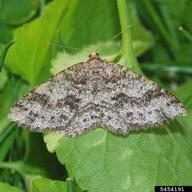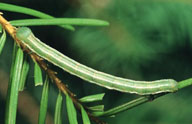Greenstriped forest looper
Melanolophia imitata (Walker) (Lepidoptera: Geometridae)
Orientation to pest
Greenstriped forest looper, Melanolophia imitata (Walker), is a native geometrid found in moist conifer forests of western North America. Adults fly in spring and lay eggs singly (up to 80 per female) on tree branches and trunks. Larvae feed on foliage of all ages, but the previous year's foliage is preferred and damage is concentrated in tree crowns. In late summer larvae drop to the ground and pupate in the litter, where they overwinter. There is one generation per year. Larvae are solitary feeders and generally are not economically damaging. However, periodic outbreaks have occurred in Canada (especially British Columbia) that were destructive to western hemlock (Tsuga heterophylla [Raf.] Sarg.). Outbreaks in the past have ended abruptly due to natural causes.
Hosts commonly attacked
This moth feeds mainly on western hemlock (T. heterophylla), Douglas fir (Pseudotsuga menziesii [Mirbel] Franco), western redcedar (Thuja plicata Donn ex D.Don), true firs (Abies), and spruce (Picea).
Distribution
This geometrid is found in western North America from Alaska to southern California and, in Canada, eastward to Alberta, in humid areas.
Images of greenstriped forest looper
| Figure 1. Adult of greenstriped forest looper, Melanolophia imitate | Figure 2. Larva of greenstriped forest looper |
Important biological control agents related to this pest species
Past studies have shown that fungal pathogens such as species of Cordyceps and Entomophthora cause significant mortality to pupae in the soil.
Web links for information on greenstriped forest looper
- Fact Sheet | Natural Resources Canada
- Fact Sheet | Ministry of Forests and Range, Province of British Columbia
- Pacific Forestry Centre Pest Leaflet | Natural Resources Canada
Articles
- Evans, D. 1962. Descriptions and life history of Melanolophia imitata (Walker) (Lepidoptera: Geometridae). The Canadian Entomologist 94: 594-605.
- Humphreys, N. 1986. Green-striped forest looper in British Columbia. Canadian Forest Service, Pacific Forestry Centre, FIDS Report No. 86-9, 43 pp.





